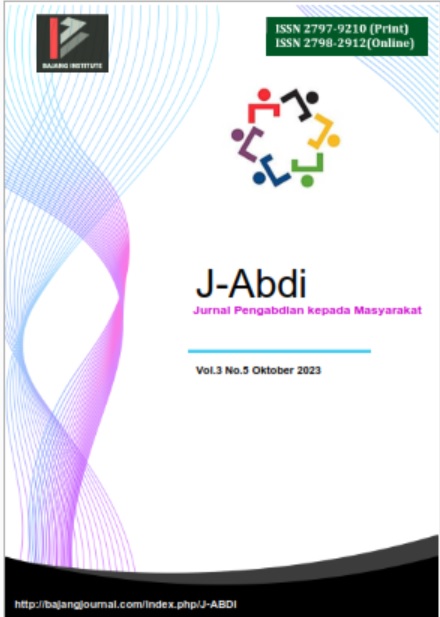PENGENALAN METODE JARIMATIKA GUNA MENINGKATKAN KEMAMPUAN BERHITUNG PERKALIAN PADA SISWA SEKOLAH DASAR
DOI:
https://doi.org/10.53625/jabdi.v3i5.6610Keywords:
Multiplication, The Finger Method, Arithmetic SkillsAbstract
The lack of numeracy knowledge among students at State Elementary School 013 Kaliamanting Island Village is a problem so further learning is needed The aim of this research was to assess the impact of using the Jarimatika method on students' multiplication abilities in classes V and VI of the Kalimanting Island State Elementary School. This research focuses on the application of Jarimatika as a tool in solving multiplication problems. The motivation for this research arose because students did not have adequate skills in dealing with multiplication, and monotonous teaching methods made learning mathematics difficult. The method used in this research is an experiment with a quasi-experimental design known as a nonequivalent control group design. The experimental group was treated with the Jarimatika method, while the control group continued to use conventional methods which included expository, question and answer and rote memorization methods. Data was collected through tests, and research results were analyzed using descriptive statistical techniques. The research results showed an increase in the average score on the pretest and posttest. From the test results, it can be seen that there is a different increase between the control group and the experimental group. The increase in the average score in the control group was 19 points, increasing from 52 to 71, while the experimental group experienced an increase of 22 points, increasing from 54 to 76. Also, the increase in multiplication calculation ability in the control group was lower than in the experimental group. These findings show that the use of the Jarimatika method has more impact on the multiplication abilities of class VI students in elementary school
References
Abdurrahman, Mulyono. 2010. Pendidikan Bagi Anak Berkesulitan Belajar. Jakarta: PT Asdi Mahasatya
Aisyah, Nyimas, dkk. 2007. Pengembangan Pembelajaran Matematika SD. Jakarta: Depdiknas.
Dewi, V. F., Suryana, Y., & Hidayat, S. (2020). Pengaruh Penggunaan Jarimatika Terhadap Kemampuan Berhitung Perkalian Peserta Didik Kelas IV Sekolah Dasar. EduBasic Journal: Jurnal Pendidikan Dasar, 2(2), 79–87.
Dwi Sunar Prasetyo, dkk. 2009. Memahami Jarimatika Untuk Pemula. Yogyakarta: Diva Press.
Himmah, K., Asmani, J. M., & Nuraini, L. (2021). Efektivitas Metode Jarimatika dalam Meningkatkan Kemampuan Berhitung Perkalian Siswa. Dawuh Guru: Jurnal Pendidikan MI/SD, 1(1), 57–68.
Indonesia, P. R. (2003). Undang-Undang Republik Indonesia Nomor 20 Tahun 2003 Tentang Sistem Pendidikan Nasional. Jakarta.
Refianti, M. (2019). Kemampuan operasi perkalian siswa tunanetra menggunakan metode jarimatika. Prosiding Seminar Matematika Dan Sains, September, 60–67.
Salsinha, C. N., Binsasi, E., & Bano, E. N. (2019). Peningkatan kemampuan berhitung dengan metode jarimatika di Sekolah Dasar Negeri (SDN) Neonbat Nusa Tenggara Timur. Transformasi: Jurnal Pengabdian Masyarakat, 15(2), 73–84.
Songgon, M. B. (2020). Penerapan Metode Jarimatika Materi Perkalian Pada Siswa Kelas 4 MI Hidayatul Mubtadiin Balak Songgon. Jurnal Ilmiah Fakultas Keguruan Dan Ilmu Pendidikan, 6(1), 32– 40.
Wulandari, Septi Peni. 2008. Jarimatika Perkalian dan Pembagian. Jakarta : PT Kawan Pust














